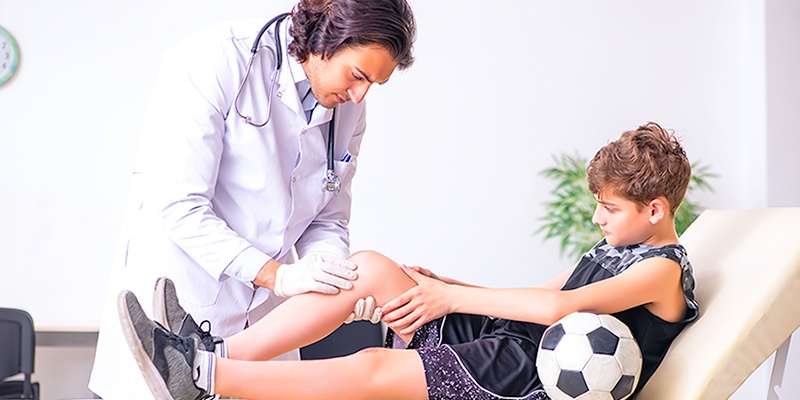Youth sports are great opportunities for children to learn confidence, leadership skills, and teamwork, among other important life lessons. But children’s bodies are young and developing, with significant differences in coordination, strength, and stamina. This makes them both more susceptible to injury and incapable of maintaining an adult training and practice regimen. Ensuring that kids practice smart techniques and play safe can enhance and lengthen their athletic journeys, thus creating lifelong enjoyment of exercise and activity.
Sports injuries can fall into two distinct categories — trauma and overuse. Trauma is an acute, or sudden injury, such as a broken bone or a sprained ankle. Overuse injuries are often the result of repetitive use, repetitive misuse, or repetitive trauma that occurs over time. The symptoms may be subtle and develop over a lengthy period of time. A very common example of an overuse injury is tendonitis.
Keep reading to learn some of the most effective youth sports safety tips you can use to help prevent both acute and overuse injuries.
Healthy habits for sports injury prevention
One of the best ways to prevent sports injuries in kids and teens is to practice healthy habits on and off the field, court, or pool. This means ensuring your child:
- Eats a healthy diet full of fruits, vegetables, and lean proteins
- Gets plenty of rest
- Stretches and warms up prior to engaging in physical activity
- Stays hydrated and drinks plenty of water
Instilling these healthy habits in your young athletes early can help prevent sports injuries in the long run so they can play without pain!
Youth sports safety tips
Integrating the following youth sports safety tips into your athlete’s routine can help prevent injuries from happening and keep your child safe and healthy.
1. Ensure your kids get sports physicals
Many schools require physicals for participation in sports, but they are also important before participating in non-school sanctioned sports at all levels. Physicals can ensure there are no pre-existing musculoskeletal or cardiac concerns. Neighbors Emergency Center offers School Physicals with EKG screenings. Book your child’s sports physical at your nearest Neighbors.
2. Encourage cross-training
Many children want to specialize in one sport, but this can lead to overplay and overuse injuries because of continuous use of the same muscles and joints. Playing multiple sports helps with strength and flexibility in a variety of muscle groups, and can help develop additional skills, such as improved footwork or strategic thinking.
3. Work on balance, flexibility, and strength
Balance, flexibility, and strength are all important components of playing sports, and they work together for skill and safety. Working on all three as part of a training program through balance training, stretching, and strength training helps advance skills and also prevent injuries.
4. Use proper equipment
Much of the equipment used in sports is for the sake of safety — helmets, mouth guards, pads, and even shoes. Make sure that you provide your child with the appropriate equipment, that it is the proper size, and that it is worn correctly. If in doubt, speak to the coach to ensure safety.
5. Emphasize and practice proper technique
Each sport has its own right and wrong way to perform movements, and it is important to follow the correct technique. Whether the movement is throwing a baseball, swinging a golf club, or jumping a hurdle; learning, practicing, and performing the action correctly will prevent injury. Explain to your child the proper way to do the action and why it’s important to practice the correct motion.
6. Follow guidelines for age-appropriate training
Children’s bodies are not fully developed, and more susceptible to injury. The American Orthopedic Society for Sports Medicine offers sport-specific guidelines for practice and training. These guidelines are based on research and should be followed to help prevent injury. Familiarize yourself with these sports injury prevention tip sheets.
7. Follow the rules
Many sports, especially for children, have rules in place with safety specifically in mind. These rules may be different than when you played, or the adult rules for the sport. Do not disparage the rules in front of your child, and encourage your child to follow them. Discuss the importance of all players’ safety with your child.
8. Discuss injuries with your athlete
Make sure your child understands that sports injuries happen and are not a failure on their part. Discuss with them that reporting injuries as soon as possible and resting & healing for as long as their physician orders are key steps to getting back to playing sports as soon as possible. Make sure your child understands that there is never a benefit to “pushing through” pain. If something hurts, they should stop immediately.
When is a sports injury an emergency?
No parent wants to see their child get injured while playing sports. While sports injuries can range in severity, some incidents require immediate medical attention. In the following situations, we recommend bringing your child to your closest ER:
- Neck or spine injuries
- Broken bones
- Dizziness, confusion, or loss of consciousness
- Slurred speech
- Difficulty breathing
Your six local Neighbors Emergency Centers are available to treat all adult and pediatric emergencies, including acute sports injuries, and refer to specialists when necessary. All of our centers are equipped with state-of-the-art imaging and lab equipment if your child needs an X-ray or another type of imaging for their injury.
Nurturing healthy habits, safety, and proper technique are the best ways to prevent injuries before they happen. Share these youth sports safety tips with your child, and work them into your regular routine.
Play safe, and have fun!


Back to Blog